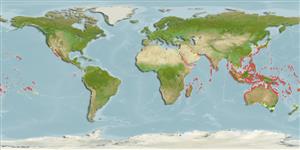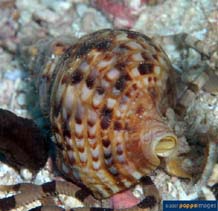Charonia tritonis (Linnaeus, 1758)
Great triton| Native range | All suitable habitat | Point map | Year 2050 |

|
| This map was computer-generated and has not yet been reviewed. |
| Charonia tritonis AquaMaps Data sources: GBIF OBIS |
Classification / Names Populärnamn | synonymer | CoL | ITIS | WoRMS
Gastropoda | Littorinimorpha | Ranellidae | Cymatiinae
Environment: milieu / climate zone / djupintervall / distribution range Ekologi
; djupintervall 1 - 40 m (Ref. 118675). Tropical
Distribution Länder | FAO områden | Ekosystem | Förekomster | Utplanteringar
Indo-Pacific: from Red Sea to Cocos Island, Costa Rica, Japan to New Zealand. Tropical and temperate.
All reports of Charonia tritonis in the Mediterranean are Charonia variegata (Ref. 114477).
Length at first maturity / Size / Weight / Age
Könsmognad: Lm ? range ? - ? cm Max length : 50.0 cm SHL hane/ej könsbestämd; (Ref. 114242)
Life cycle and mating behavior Könsmognad | Reproduktion | Lek | Eggs | Fecundity | Larvae
Main reference
referenser | Koordinator | Medarbetare
Smith, B.D. 2003 Prosobranch gastropods of Guam. Micronesia 35-36:244-270. (Ref. 3116)
IUCN Red List Status
(Ref. 130435: Version 2025-1)
CITES status (Ref. 108899)
CMS (Ref. 116361)
Threat to humans
Human uses
| FishSource |
Verktyg
Ytterligare information
Max. ages / sizes
Length-weight rel.
Length-length rel.
Length-frequencies
Mass conversion
Abundans
Internet-källor
BHL | BOLD Systems | CISTI | DiscoverLife | FAO(Publication : search) | Fishipedia | GenBank (genome, nucleotide) | GloBI | Gomexsi | Google Books | Google Scholar | Google | PubMed | Tree of Life | Wikipedia (Go, sök) | Zoological Record



